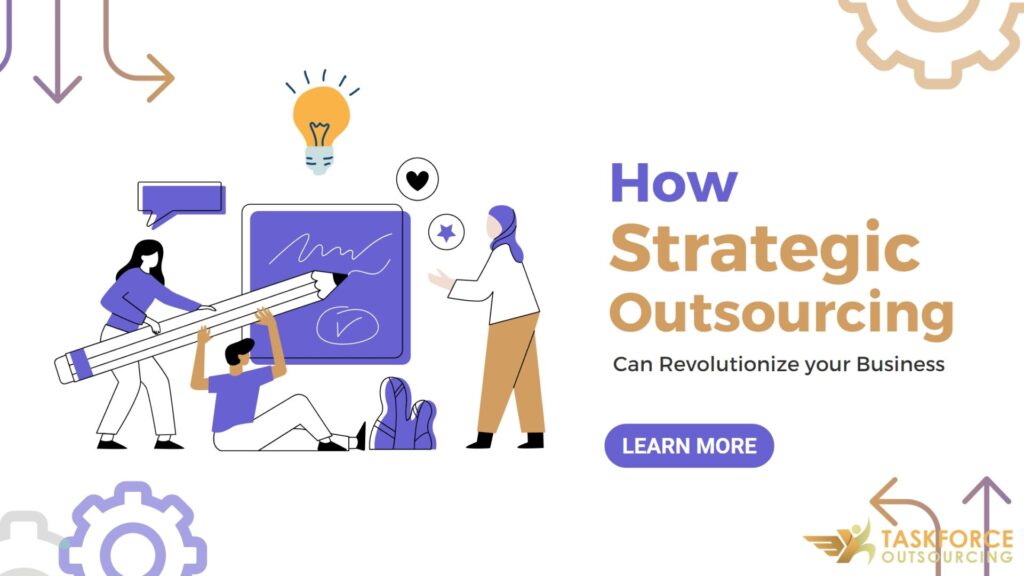Running a successful business requires a delicate balance between focusing on core competencies and managing non-core activities efficiently. Many companies are realizing the immense benefits of strategic outsourcing, a practice that allows them to offload non-core tasks to specialized service providers, enabling them to concentrate on what they do best. By revolutionizing your business with strategic outsourcing, you can unlock new opportunities for growth, streamline operations, and achieve higher levels of success. This article will guide you through the roadmap of strategic outsourcing, helping you navigate the process effectively.
Contents
- 1 Introduction
- 2 Understanding Strategic Outsourcing
- 3 Steps to Strategic Outsourcing
- 4 Assessing Your Business Needs
- 5 Choosing the Right Outsourcing Partner
- 6 Creating a Comprehensive Outsourcing Strategy
- 7 Implementing the Outsourcing Plan
- 8 Overcoming Challenges and Mitigating Risks
- 9 Measuring and Optimizing Outsourcing Success
- 10 Real-Life Case Studies & Examples of Successful Outsourcing
- 11 Conclusion
Introduction
In today’s rapidly evolving business landscape, companies are under increasing pressure to stay competitive, reduce costs, and deliver exceptional customer experiences. Strategic outsourcing has emerged as a game-changing solution, offering businesses a way to optimize resources, access specialized expertise, and gain a competitive edge.
Understanding Strategic Outsourcing
What is Strategic Outsourcing?
Strategic outsourcing is a proactive approach where companies strategically select specific non-core activities and partner with external service providers to perform those tasks. It involves a comprehensive analysis of business processes, identifying areas that can be efficiently handled by external experts, and then delegating those tasks to them. This allows businesses to focus on their core competencies while leveraging the specialized skills and resources of outsourcing partners.
Benefits of Strategic Outsourcing
Strategic outsourcing brings numerous advantages to businesses. Firstly, it allows organizations to reduce costs significantly by leveraging the expertise of service providers who can perform tasks more efficiently and at lower costs. Moreover, outsourcing enables businesses to tap into a global talent pool, accessing specialized skills and knowledge that may not be available internally. It also provides flexibility and scalability, allowing businesses to quickly adapt to changing market demands. Strategic outsourcing ultimately enhances operational efficiency, quality, and innovation while enabling businesses to stay ahead of the competition.
In our previous article, Outsourcing vs. In-house Hiring: Which is Right for Your Startup?, we discuss in detail the advantages and disadvantages of outsourcing vs. hiring employees internally.
Steps to Strategic Outsourcing
Assess your Business Needs
Choose the Right Outsourcing Partner
Create a Comprehensive Outsourcing Strategy
Implement the Outsourcing Plan
Overcome Challenges and Mitigate Risks
Measure and Optimize Outsourcing Success
Assessing Your Business Needs
Identifying Core Competencies
To embark on the strategic outsourcing journey, it is crucial to identify your organization's core competencies. These are the unique capabilities that give your business a competitive advantage. By focusing on these core areas, you can allocate resources more effectively and maximize your business's potential.
Analyzing Non-Core Activities
Conduct a thorough analysis of your business processes to identify non-core activities that can be outsourced. These activities typically include administrative tasks, IT support, customer service, and repetitive processes. By outsourcing these non-core activities, you can free up resources and allocate them to more strategic initiatives.
Determining Outsourcing Potential
Once you have identified non-core activities, assess their outsourcing potential. Consider factors such as cost savings, efficiency gains, access to specialized expertise, and scalability. This analysis will help you prioritize the activities that are most suitable for outsourcing.
Choosing the Right Outsourcing Partner
Selecting the right outsourcing partner is crucial for the success of your strategic outsourcing initiative. Consider the following factors when evaluating potential partners:
Evaluating Expertise and Experience
Assess the expertise and experience of outsourcing providers in your industry or the specific services you require. Look for a track record of successful projects and client testimonials. A knowledgeable and experienced partner will bring valuable insights and best practices to the table.
Assessing Cultural Compatibility
Cultural compatibility is essential when working with an outsourcing partner. Ensure that their values, work culture, and communication style align with your own organization's ethos. Effective collaboration and understanding between both parties will contribute to a seamless outsourcing experience.
Ensuring Communication Channels
Clear and open communication is vital for a successful outsourcing partnership. Verify that the potential partner has effective communication channels in place, such as regular meetings, progress reports, and dedicated points of contact. A strong communication framework fosters transparency, trust, and efficient problem-solving.
We discuss the topic of Culturing Compatibility more in our previous article: Cultural Compatibility in Outsourcing: Why the Philippines is Ideal for Australian Businesses.
Creating a Comprehensive Outsourcing Strategy
Developing a well-defined outsourcing strategy is key to achieving your business objectives. Consider the following steps when creating your strategy:
Defining Objectives and Goals
Clearly articulate your objectives and goals for outsourcing. Determine what you aim to achieve, whether it's cost reduction, process improvement, or accessing specialized skills. Setting specific, measurable, attainable, relevant, and time-bound (SMART) goals will provide a clear roadmap for your outsourcing journey.
Setting Key Performance Indicators (KPIs)
Establishing relevant Key Performance Indicators (KPIs) helps measure the success and effectiveness of your outsourcing efforts. Identify metrics that align with your objectives, such as cost savings, quality improvements, customer satisfaction, or time-to-market. Regularly track and evaluate these KPIs to ensure continuous improvement.
Establishing a Transition Plan
A well-planned transition is crucial when implementing outsourcing. Develop a comprehensive transition plan that outlines the timeline, responsibilities, and processes for transferring tasks from your organization to the outsourcing partner. Effective change management and clear communication during the transition phase minimize disruption and ensure a smooth handover.
Implementing the Outsourcing Plan
Once you have selected an outsourcing partner and defined your strategy, it’s time to implement the plan. Consider the following aspects during the implementation phase:
Effective Project Management
Establish effective project management practices to ensure smooth execution of outsourced tasks. Define roles and responsibilities, set deadlines, and establish regular communication channels. Regularly monitor progress and address any issues promptly to keep the project on track.
Monitoring and Quality Control
Maintain a system for monitoring and controlling the quality of outsourced work. Implement regular performance assessments, quality audits, and feedback mechanisms. This ensures that the outsourcing partner meets your expectations and maintains consistent quality standards.
Ensuring Data Security and Confidentiality
Data security and confidentiality are critical considerations when outsourcing. Establish robust security protocols, including non-disclosure agreements and data protection measures. Regularly review and assess the outsourcing partner's security practices to safeguard your sensitive information.
Overcoming Challenges and Mitigating Risks
Outsourcing initiatives may face challenges and risks that need to be effectively managed. Consider the following strategies to mitigate potential issues:
Managing Change within the Organization
Outsourcing often involves organizational changes. Proactively manage the impact of these changes by communicating the benefits, addressing employee concerns, and providing training and support. A well-managed change process promotes employee buy-in and ensures a smooth transition.
Mitigating Outsourcing Risks
Identify and assess potential risks associated with outsourcing, such as service interruptions, data breaches, or vendor instability. Develop risk mitigation strategies and contingency plans to address these risks. Regularly review and update risk management procedures to adapt to evolving circumstances.
Building Strong Vendor Relationships
Maintaining a strong and collaborative relationship with your outsourcing partner is crucial for long-term success. Foster open communication, address concerns promptly, and establish regular performance reviews. Building a partnership based on trust and mutual understanding strengthens the outsourcing engagement.
Measuring and Optimizing Outsourcing Success
Continuously measuring and optimizing your outsourcing efforts ensures ongoing success. Consider the following approaches:
Tracking Key Metrics and Performance
Regularly track and evaluate key metrics identified in your outsourcing strategy. Compare actual performance against the set KPIs and benchmarks. Use this data to identify areas for improvement, address bottlenecks, and optimize processes.
Continuous Improvement Strategies
Implement a culture of continuous improvement within the outsourcing partnership. Encourage the outsourcing provider to suggest process enhancements, identify efficiencies, and propose innovative solutions. Collaborative improvement efforts drive ongoing value and optimize the outsourcing relationship.
Flexibility and Scalability
Ensure that your outsourcing partnership offers flexibility and scalability to accommodate changing business needs. As your business grows or requirements evolve, the outsourcing provider should have the ability to scale resources, adjust processes, and adapt to new challenges.
Real-Life Case Studies & Examples of Successful Outsourcing
Case study #1: WhatsApp
Streamlining Operations and Reducing Costs
WhatsApp is a popular messaging app that started as a small company with a capital of $250,000 in 2012 and had only 30 full-time employees and five part-timers. They relied heavily on outsourcing software and core development. While maintaining an office in the U.S. for customer service, WhatsApp outsourced their app development. This helped them reduce costs and build a successful product. Later in 2014, Facebook acquired the company for $19 billion.

Case study #2: CuriosityStream
Accelerating Innovation and Time-to-Market
CuriosityStream is a global independent media company and video-on-demand streaming service. In 2019, they decided to try outsourcing and hired a team of six programmers who helped them develop a video feature that increased the number of hours watched. This enabled rapid product development and increased their overall productivity and reduced the cost required to make the software.

Case study #3: Alibaba
Expanding Global Presence and Market Reach
Alibaba, a retail e-commerce business, expanded its global presence and market reach through strategic outsourcing. In his autobiographical novel, Jack Ma, the founder of Alibaba, discussed how the company decided to outsource its website development in its early years in 1999. The goal was to appeal to a bilingual audience by localizing the website for both English and Chinese speakers. This decision laid the foundation for Alibaba to become a multinational business and grow into the successful company it is today.

Conclusion
Strategic outsourcing is a powerful tool that can revolutionize your business, enabling you to focus on core competencies while benefiting from specialized expertise and cost efficiencies. By following the roadmap outlined in this article, you can navigate the outsourcing journey successfully. Remember to assess your business needs, choose the right partner, create a comprehensive strategy, implement effectively, and continuously measure and optimize for long-term success.
Frequently Asked Questions (FAQs)
A: Outsourcing refers to the practice of delegating specific tasks or processes to external service providers, regardless of their geographical location. Offshoring, on the other hand, specifically involves outsourcing to a foreign country. While offshoring often focuses on cost savings, outsourcing can encompass both domestic and international partnerships.
A:Strategic outsourcing improves business efficiency by allowing companies to focus on core competencies while delegating non-core activities to specialized service providers. This leads to cost savings, access to expertise, enhanced quality, increased scalability, and improved operational flexibility.
A: Data security is a crucial consideration when outsourcing. It's essential to establish robust security protocols, including non-disclosure agreements and data protection measures, to safeguard sensitive information. Regularly reviewing and assessing the outsourcing partner's security practices ensures data security and confidentiality.
A: Various activities can be outsourced, including IT support, customer service, human resources, accounting and finance, marketing, content creation, and logistics. The key is to identify non-core activities that can be efficiently handled by external experts, freeing up internal resources for more strategic initiatives.
A: Choosing the right outsourcing partner requires evaluating their expertise, experience, cultural compatibility, and communication channels. Look for a partner with a proven track record, relevant industry experience, and a strong cultural fit. Effective communication and collaboration are vital for a successful outsourcing partnership.
Strategic outsourcing can be the catalyst for revolutionizing your business. Don’t be afraid to take the leap and explore the benefits of strategic outsourcing. Embrace the power of working with a team of experts who can help you navigate the complexities of your industry, while you focus on your core competencies and strategic goals.

With an experienced partner like Taskforce Outsourcing by your side, you can tap into skilled and specialized talent without having to worry about any of the complexities associated with managing outsourced teams. Let us help you bring your business dreams one step closer!
We are committed to quality services at an affordable price, and to helping small businesses grow and succeed through outsourcing. Contact us today to learn how we can be your outsourcing partner and support your business success.

